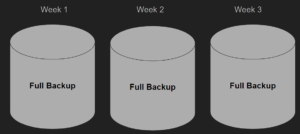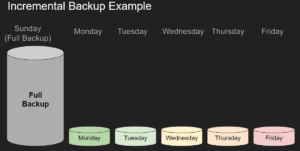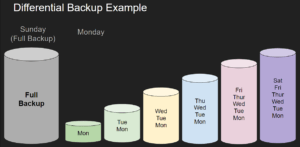Full Backup
Full Backup
A full backup involves copying all selected data at a specific point in time. It creates a complete replica of the entire dataset.
Typically performed periodically (e.g., weekly) to create a baseline backup.
Restoring Full Backups
Restoring full backups is simple. You need only choose the date of backup that you wish to restore from and use that file.
Pros & Cons for Full Backups
Advantages
- Simple and straightforward.
- Restoration is fast since all data is in one place.
Disadvantages
- Consumes more storage space compared to other types.
- Takes longer to complete the backup process.
Incremental Backup
Incremental Backup
An incremental backup captures only the changes made since the last backup, whether it was a full or incremental backup. It saves storage space by not duplicating unchanged data.
Often performed daily to capture daily changes without creating a complete copy each time.
Restoring from Incremental Backup
Restoring from an incremental backup requires the full backup plus all of the individual backups between then last full backup and the day your want to restore from.
If any of the backups are corrupted then you cannot restore from that point or beyond.
Pros & Cons of Incremental Backups
Advantages
- Requires less storage space compared to full backups.
- Faster backup process as only changes are transferred.
Disadvantages
- Restoration may be slower, as it requires the most recent full backup plus all subsequent incremental backups.
- If one incremental backup is corrupted, the entire chain from that point forward may be affected.
Differential Backup
Differential Backup
A differential backup captures all changes made since the last full backup. Unlike incremental backups, it doesn’t rely on the previous differential backups; each differential backup contains all changes since the last full backup.
Useful for situations where daily differential backups are more manageable than daily full backups.
Restoring Differential Backups
Restoring from a differential backup requires the full backup plus the latest good backup.
If the latest backup is corrupted or otherwise unusable then the previous day’s backup can be used.
Pros and Cons of Differential Backups
Advantages
- Faster restoration compared to incremental backups, as it only requires the last full backup and the most recent differential backup.
- Takes up more space than incremental backups but less than full backups.
Disadvantages
- Consumes more storage space than incremental backups.
- Over time, the size of the differential backup may approach that of a full backup.


